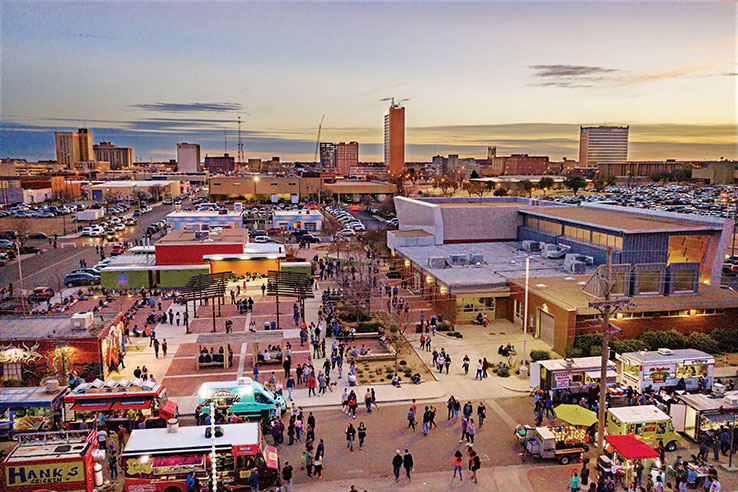
Published in Platform: Urban Agencies—Projections for the Contemporary City, pg 50
Samantha Whitney Schwarze, M. Arch, Urban Design, 2013
Learning from Lubbock
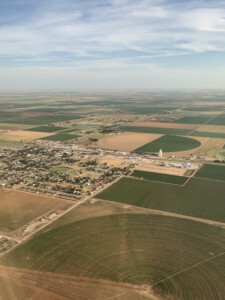
As a graduate of the School of Architecture’s (UTSOA) Urban Design program and director of the urban design practice area at Overland Partners, I constantly strive to bridge what I have learned in school with what I continue to learn in my everyday work. For me, work is a fully immersive experience—a labor of love. It includes a heavy responsibility to research and engage with people to begin understanding the complex definitions of a place. While even then you cannot fully know the contours of a place and the many people who have shaped it, the process of pursuing that understanding builds trust and propels the work closer to identifying meaningful recommendations for how to move forward. Following this approach, each project yields a heightened awareness for the strategies and tools that work best in that context and teaches you something you did not know before.
Cities are like people: they have characteristics that are not easily summarized; they are alive; they are imperfect; they are constantly changing; they need our attention, our affection, and our care to grow, thrive, and become more equitable. While cities have unique narratives that make up their larger story, from their raison d’être to current challenges they face, they share common threads we can learn from and apply to other contexts as we continue to advance towards a more sustainable future.
Bringing people together to create a community-centered vision was at the heart of a recent master plan our team undertook for the car-centric city of downtown Lubbock, Texas. The goal, in part, was to bring life back to the center of the city and transform downtown into a more vibrant, walkable place—not just during the day, but in evenings, on weekends, and throughout the year. Over the course of four intensive months, through engagement, research, and collaboration, we presented the Downtown Lubbock Master Plan Update to City Council in January 2020, which was unanimously adopted as policy this past June.
What began as a straightforward scope of work to formally coalesce prior plans into a single policy document with a motivated master developer, Downtown TIF Board, and a City Council ready for action, resulted in a transformational experience that has built consensus around the future of downtown Lubbock while also deeply impacting me as an urban designer. What can be learned from Lubbock are transferrable lessons that are relevant to other car-centric cities in Texas who are coming to realize that a vibrant urban core is essential to their long-term growth and success, and that this requires re-examining their plans and policies. Lubbock can serve as a strong case study for cities facing similar challenges and seeking a new path forward.
Philosophy/Process
During my time at the UTSOA, I immersed myself in case-study research and analysis of the physical and cultural contexts of a place by layering aerial photography, historic maps, and regulatory frameworks on top of one another. This method allowed me to study at a fine-grain level of detail how urban connections can be repaired and how new programs can be introduced to benefit a community and strengthen existing urban patterns. I learned how designing for higher densities, connecting with transit and other modes of mobility, and accommodating high-performing buildings can conserve energy, minimize waste, and optimize the carbon footprint of architecture and urban development in cities.
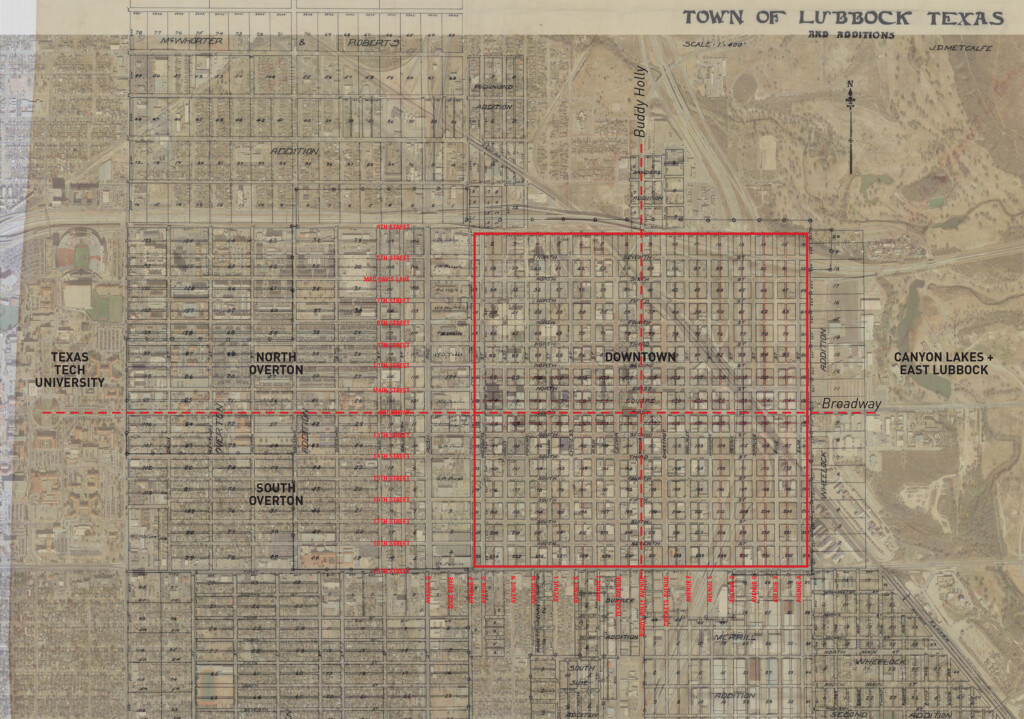
In practicing urban design at Overland, I have been able to apply my training and technical skills and combine them with an awareness for articulating a project’s social needs and human-centric goals, for which Overland is known. One of the core values and a key element to how we approach design is through collaboration. We invite stakeholders into the process by actively engaging, listening closely, and building consensus with the broader community to understand a project’s aspirations and desired outcomes.
Merging these experiences was key to a fruitful process for the Downtown Lubbock Master Plan Update when Overland was selected in 2019. Led by an all-female, all-UTSOA urban design alumnae team—Sam Whitney Schwarze, AIA (M. Arch. ‘13), Noel Kuwabara, AIA (MSUD ‘18), and Aparajita Bhatt, LEED ND (MSUD ‘17)—we worked closely to address each scope area thoroughly while ensuring that we met with and included city leadership, staff, downtown business owners and arts non-profits, historical society representatives, developers, and members of the community in the conversation. Using a workshop format, we had fun tools on hand to navigate difficult conversations and encourage active participation. This created an enthusiasm for the work and reignited momentum for downtown.
They have immersed themselves in our community, they have gotten to know our personality, they have fallen in love with us.
— Brianna Gerardi, Business Development Director, City of Lubbock
Overland’s involvement in Lubbock began in 2004 when Rick Archer, FAIA (B.Arch. ’79) and Bob Shemwell, FAIA (M. Arch. ’87) led the master planning efforts for the fledgling Louise Hopkins Underwood Center for the Arts (LHUCA), which at the time was a small non-profit comprising individuals who had a vision for a vibrant arts community, most notably, Louise Hopkins Underwood. Underwood’s vision and tenacity unfolded into a four-block campus with 64,000 square feet of exhibit space that hosts thousands of people every first-Friday of the month, year-round, as part of its free, self-paced First Friday Art Trail, a major initiative to emerge from the LHUCA master plan. It has become an incubator for community building through arts and culture, drawing people from all walks of life to the most exciting and well-attended event in what is normally a dormant downtown.
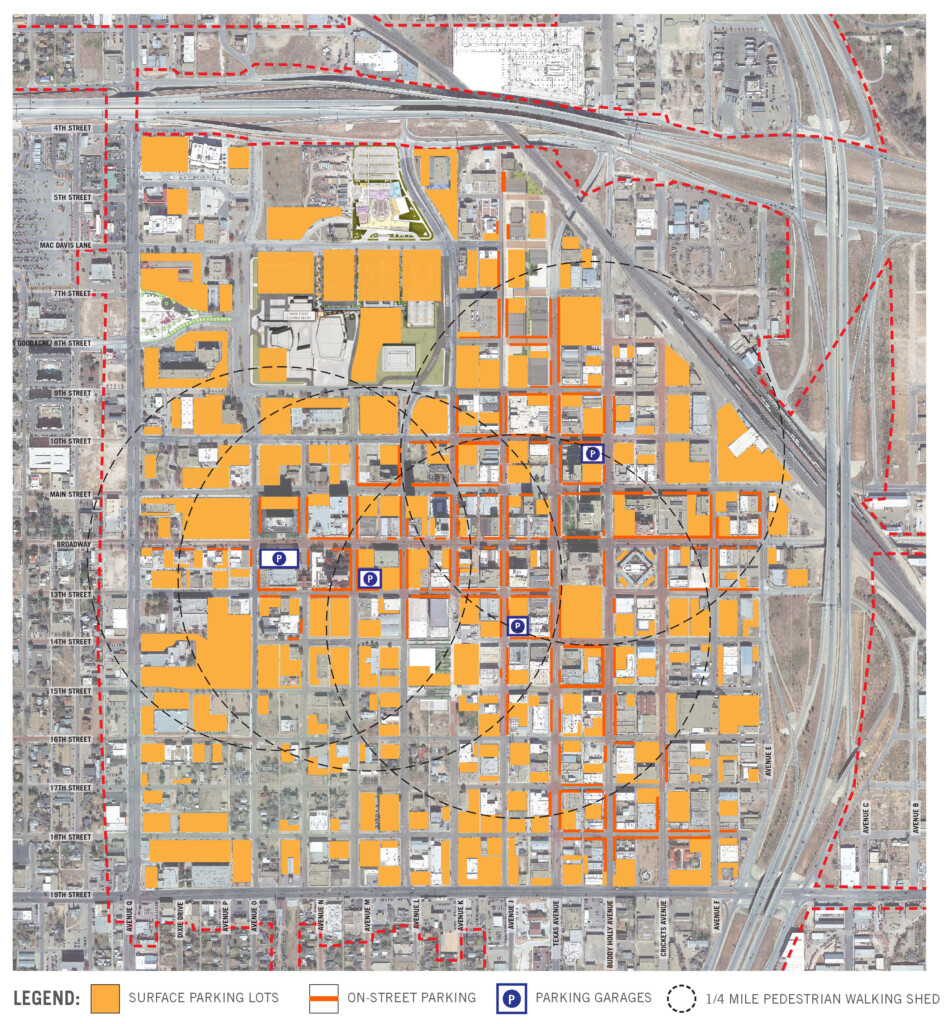
The Master Plan builds upon the energy of First Friday and existing cultural assets in the city including LHUCA, the Charles Adams Studio Project (CASP) gallery and artists-in-residence studios, the Buddy Holly Center (museum to the famed music icon/Lubbock native) and focuses attention and infill development around emerging catalysts such as the recently completed renovation of Citizen’s Tower to house the City of Lubbock offices and the soon-to-be-completed Buddy Holly Hall, a state-of-the-art performing arts venue.
Unsustainable Growth and the Future of Downtown
On my first trip to Lubbock last summer, I arrived by plane where I saw from above what looked like immeasurable expanses of agricultural lands where water-thirsty cotton, corn, and sorghum have been a mainstay for more than a century. The regularity of the gridded landscape was peppered with center-pivot irrigation patterns. On a subsequent road trip by car from San Antonio with colleagues Noel and Aparajita, I began to appreciate how flat Lubbock is.
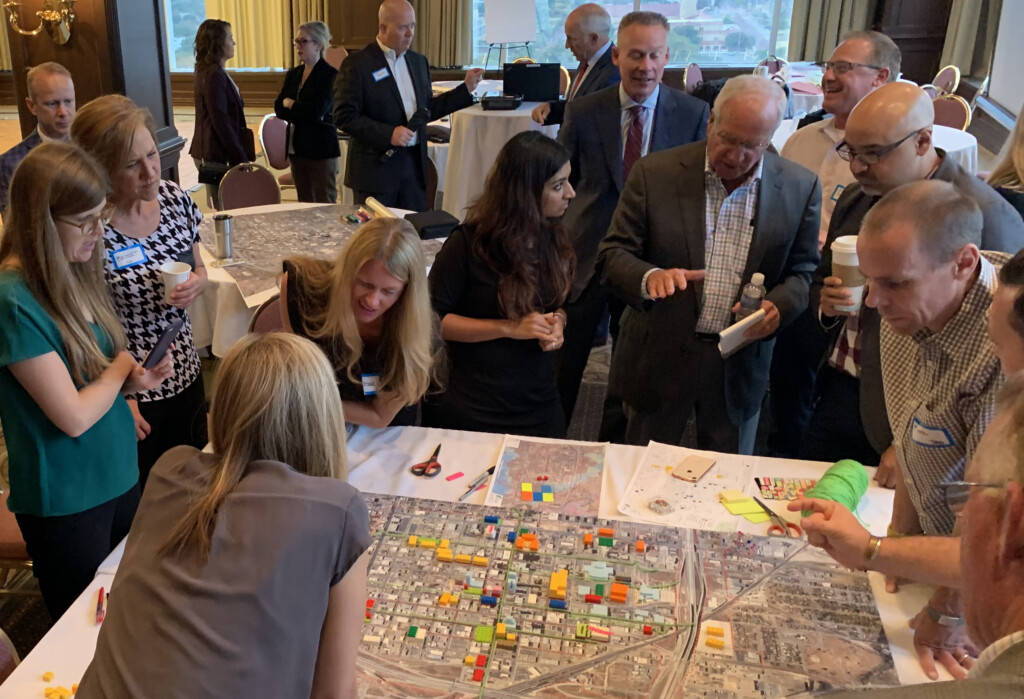
Approaching the South Plains by ascending and then reaching the plateau of the Caprock was a strange sensation. The flatness of the landscape combined with the bigness of sky distorted my perceptions. I was no longer aware of the speed at which we were driving and the distance we were covering. The view was punctuated by the sinuous lines of wind turbines following prevailing wind patterns as far as we could see. I began to wonder if we would ever reach Lubbock. How could there be a city in the center of this infinite horizon?
There is, in fact, a city in the middle of that vast landscape, one that continues to grow its low-density suburban limits boundlessly like the surrounding agricultural fields. The agrarian land structure, organized on a one-mile by one-mile grid, determined the original development patterns in the older areas of Lubbock. The bustling downtown, Texas Tech University, and surrounding residential neighborhoods such as North Overton, South Overton, Tech Terrace, and Rush were all organized, subdivided, and interconnected within this regular grid.
During the twentieth century, the city limits continued to grow one square mile at a time with the pace of growth accelerating in recent decades as new subdivisions have cropped up to the south and west. This growth continues to put financial strain on a city that has subsidized the infrastructure to support it. It also adds stress to the already-strained Ogallala Aquifer, which has sustained cotton and other non-native crops through droughts and other climate change effects in the region. A second highway loop is planned to connect the outer suburban developments, which could continue to spur corridor-type retail and low density and eventually blur the distinction between where the Lubbock ends and the neighboring towns of Wolfforth and Shallowater begin. This trajectory of growth is unsustainable, and the city knows it. The extraterritorial jurisdiction (ETJ) has now reached a land area of over 364 square miles for a population of just over 250,000. Lubbock’s recent comprehensive plan addresses the need for diversifying land use within the ETJ and encouraging infill development in key places across the city, especially downtown. The City has also committed to updating its unified development code (UDC) and will incorporate form-based codes into its regulatory frameworks, specifically in the downtown area.
Downtown Lubbock and the Master Plan Focus
While the lion’s share of the City’s attention and investment has occurred primarily at the city’s periphery, downtown has experienced years of deferred maintenance and has only recently begun being taken seriously as a viable market for development. This development delay has left a mark on downtown in the form of a high degree of building vacancies, a lack of basic services and programs such as housing and local retail, and the value of real estate is exceptionally low.
The scale of downtown is also very large, disproportionately so for its population. Less than one percent of Lubbock’s residents live downtown while the central business district (CBD) is roughly comparable in land area to the CBDs of Austin, Houston, and Dallas, but with a fraction of the building mass, height, and density, and real estate valuation of those cities. Measuring roughly 300×300 feet, its block scale is similar to downtown Austin, but with even wider streets. The major street rights-of-way measure one-hundred feet, which is twenty feet wider than the Great Streets of Austin!
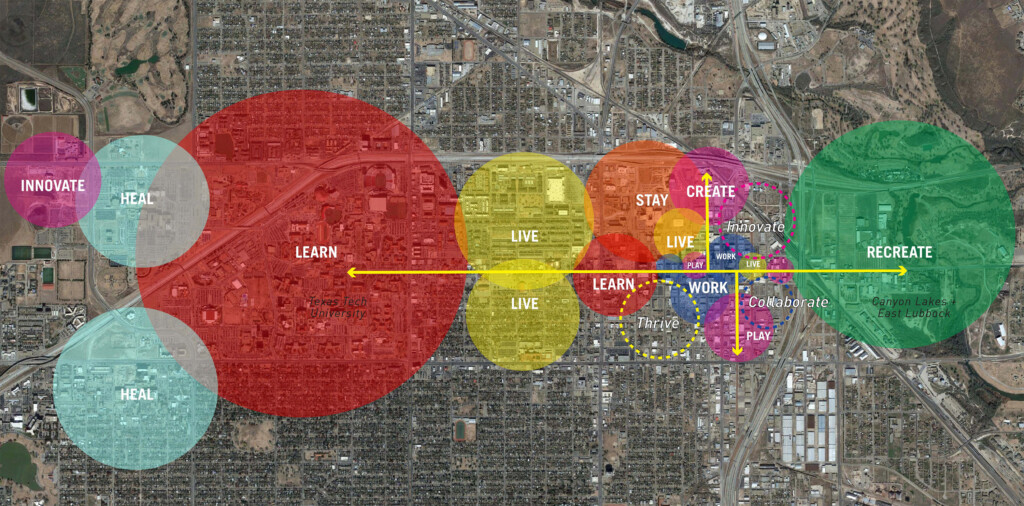
The predominant land use is surface parking with little to no open space or parks. Over 145 acres are dedicated to the storage of cars with the perennial opinion that there is no place to park downtown. With few exceptions, downtown consists of buildings in dire need of renovation, some of which, in their current states, are not particularly valuable, while other buildings may contribute in mid-century modern historic value, but will need care to improve their status.
The vision is to reposition downtown as the urban center of Lubbock, with Broadway reawakened as a dynamic spine that connects Texas Tech University to the Canyon Lakes. Given the challenges of the large-scale land area, low real estate valuation, high degree of building vacancy, low absorption rate for new housing, retail, and other uses, the Master Plan targets specific areas of downtown in order to create a cohesive framework for open space and infill development that revitalizes the city.
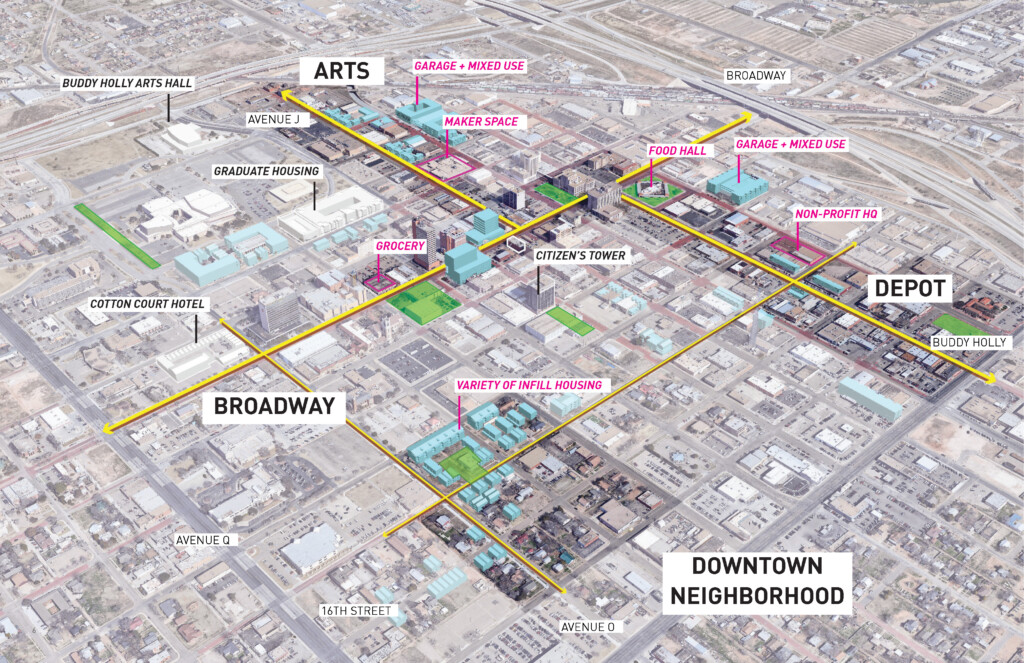
The Framework is structured around the key zones of Broadway, Arts, and the Depot districts. Reinforcing these districts and their connections to Broadway will stimulate growth outward across the city over time. With a focus on preparing the city for prioritized improvements to the public realm through immediate, implementable change, the master plan addresses much-needed upgrades to parks, open space, and utilities infrastructure, repurposes existing historic building stock, and improves streetscapes to create a more walkable urban environment. Supported by a holistic approach to parking management, strategies for investment are intended to achieve the highest degree of impact with the least amount of capital investment.
A central component to the framework is a new civic park on Broadway to bring more people to downtown, creating a gathering space in the heart of the city. The park concept is intended to be incrementally implemented with pop-up activations to test ideas with key stakeholders, business owners, and the public. This cost-effective strategy will allow the city to quickly gain insight into what programs and activities will succeed over time as the space matures into a fully built-out civic park.
Key Takeaways
The intent in updating the Master Plan was to equip the City with tools to implement immediate change, including pilot programs in public art, placemaking, and updating zoning ordinances to elevate the standard of care for existing buildings, encourage a mix of uses, and relax parking requirements to encourage shared parking and walkability. Most importantly, the intent is to change the paradigm of downtown and ignite positive change in the mindset of the people that downtown is important to the vitality Lubbock and is home to an authentic experience not found elsewhere in the city.
The Master Plan includes an implementation matrix calibrated to the existing governance structure of the City with a roadmap forward for establishing a non-profit advocacy group with a broader group of stakeholders who are focused on the health and vitality of downtown Lubbock. As the shepherd of the Master Plan, I interviewed and convened the disparate groups who were not included or aligned before. Having a shared vision for the revitalization of downtown, and equipped with action items categorized in immediate, mid-term, and long-term timelines, this group will lead the implementation of the Master Plan.
Beginning with policy change for parking and vacant buildings, in addition to launching pop-up activations and public art installations, these first steps will send the message that downtown is coming back to life. Following, the design of the Civic Plaza, the development of a parking master plan, and the pursuit of an historic district will transform downtown immediately and over the coming years. Together, the elements of the master plan will shape memorable experiences that engage citizens, students, and visitors in personal and meaningful ways.
Sometimes you hire consultants, and they swoop in, do whatever, and fly out. You guys have done a great job. You’ve built relationships in our community, you’ve taken it very seriously, and that’s something that’s not lost on us, we’re very thankful for that.
— Dan Pope, Mayor, City of Lubbock
Project Team
Overland: Urban Design/Master Plan Lead
TBG: Landscape, Parks, and Open Space
Seventh Generation Design: Historic Preservation Analysis
Landwise: Land Use Market Analysis
Gabriel’s Horn Town Builders: Regulatory Framework Gap Analysis
WGI: Civil, Traffic, Parking, Utilities Infrastructure
Hugo Reed: Utilities Infrastructure
Creating places that can’t be built by anyone else
…for anyone else.

